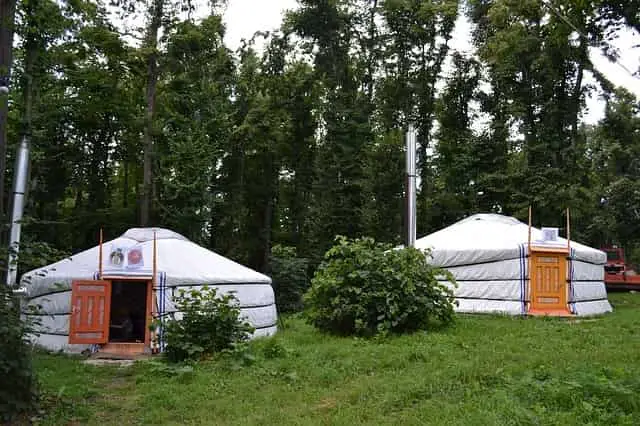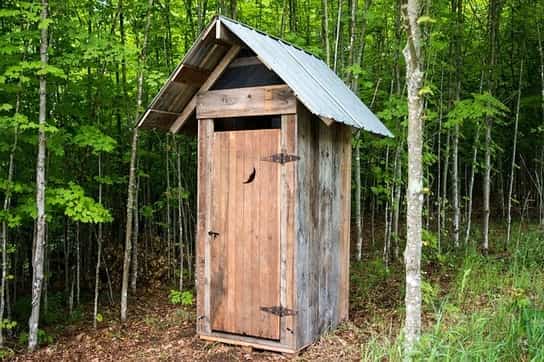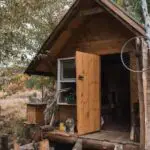
Yurts are often built as semi-temporary living structures resembling large circular tents. Although they are basic, modern yurts can include many amenities.
But…Do yurts have bathrooms?
Table of Contents
- Do Yurts Have Bathrooms?
- How to Add a Bathroom to a Yurt
- Alternative Bathroom Ideas for a Yurt
- Can You Add a Shower and Sink in a Yurt?
- Can You Add a Kitchen to a Yurt?
Do Yurts Have Bathrooms?
Traditional Yurts do not have a bathroom. Instead, an outhouse or outbuilding is used. Modern yurts are often equipped with full plumbing and partitions to allow for bathrooms and showers inside. Other Yurts may have a composting toilet and ventilation system but still allow for bathroom privacy.
Putting a bathroom in a yurt is possible but involves extra work. Including a modern bathroom in a yurt often requires a raised base with space for plumbing. Depending on the location, the plumbing may connect to a sewer or septic system.
Here is what you should know before attempting to add a toilet to your yurt.
How to Add a Bathroom to a Yurt
Yurts are typically circular structures with wood frames. Some yurts are portable and set up as temporary structures while others are permanent. Permanent yurts typically sit on wood decks or slab foundations.
The type of yurt that you build determines the type of bathroom you can add. For example, you need to build a permanent structure if you plan on adding plumbing for a bathroom.
With a temporary yurt, you may need to find alternatives to modern plumbing, such as using an outhouse or a composting toilet.
If you build a permanent yurt, pay attention to the following details to add a bathroom:
- Building codes
- Plumbing
- Electricity
- Ventilation
- Privacy
Before you start installing a bathroom in your yurt, review the building codes for your local area. Some regions may prohibit you from adding plumbing or electricity to a yurt, especially if it is a temporary yurt. If plumbing and electricity are permitted, you may need to obtain a building permit before you start work.
Working with a professional contractor or builder can help you navigate your local building codes. Experienced professionals should already know most of the requirements for adding a bathroom to a building.
Most bathrooms include plumbing unless you plan on using a camping toilet or a composting toilet. A drainpipe runs from the toilet to the main sewage line or the septic tank to dispose of bathroom waste. Sinks and showers will also drain to the same line.
The plumbing is typically connected to a public or private water system underneath the yurt. Building the yurt on a raised platform, such as a wood deck, gives you space for running pipes and electrical wires. The pipes then reach through the floor or into a wall.
Along with a drainage line, you need a water supply to flush the toilet. You may also want water for sinks and a shower. The most common sources include the public water supply, a private well, or external water storage, such as a rainwater collection system.
Electricity is necessary if you want to have lights, ventilation fans, or an electric water heater. As with the plumbing, the electrical wiring is installed underneath the yurt. You can run wire through wall partitions for lighting or electrical outlets.
Ventilation is needed to help prevent condensation and moisture, which can increase the risk of mold and mildew growth on the outer walls of the yurt. Adding downdraft vents in the floors or ventilation fans in the wall can help vent moist air outside.
You may also want to ensure that your bathroom offers privacy. The most common solution is to build a wall frame to section off the bathroom. At least two wall partitions are added to create a separate room in the corner of the yurt. One of the partitions can include a door.
You can either leave the top of the bathroom exposed or frame it. Adding a frame allows you to include an enclosed ceiling above the bathroom for increased privacy and better ventilation. You could also use the space above the bathroom as a loft or storage area, depending on the size of the yurt.
An alternative to framing is to use a shower curtain or portable wall partitions. Hang a curtain or set up partitions to separate the bathroom area.
Alternative Bathroom Ideas for a Yurt
A modern bathroom may not work in every yurt. Some sites may not include access to a sewer system or a septic tank. You may also lack electricity or enough space inside your yurt to fit a bathroom.
Here are a few alternative bathroom ideas:
- Composting toilets
- Camping toilets
- Yurt bathhouse
- Outhouses
- Shower tents
Using a composting toilet or a camping toilet may work for those without access to water or electricity. Composting toilets come in two basic designs.
Most composting toilets are self-contained units that include a compositing system below the toilet bowl. Other designs use pipes to send waste to a composter installed away from the yurt.
A self-contained composter is the most common option, as it does not require extra plumbing. However, you need to occasionally empty the compost from a container to keep the toilet from overflowing. Composting toilets do not require water.
Your waste is sent to a compost pile, either below the toilet or in a separate system, where it gradually breaks down into compost.
A camping toilet is the easiest solution. The typical camping toilet is a bucket with a liner and a toilet seat. Cat litter is added to the liner to help eliminate odors. You do not need to install anything to add a camping toilet, which makes it a suitable option for temporary yurts.
However, you may need to empty the camping toilet several times per day. You and other occupants of the yurt may also dislike the idea of a waste bucket sitting inside the yurt.
Instead of using space inside your yurt for a bathroom, you could build a second yurt to use as a bathhouse.
A yurt bathhouse may not require interior framing or curtains for privacy. It is essentially a one-room bathroom with a tub, toilet, and sink. You could also connect the two yurts with a breezeway or hallway.

An outhouse is another option for adding a toilet on your land without using up space inside your yurt. Building an outhouse should cost less compared to building a yurt bathhouse. Outhouses are typically built over a hole measuring at least four feet deep.
While many people picture old wooden structures, outhouses can include modern amenities. You can even build outhouses with siding, insulation, and finished interiors.
The last option for adding a bathroom to your property is to set up a shower tent with a camping toilet. Shower tents are tall tents with small footprints. You can also hang a camp shower from the ceiling of the tent.
Can You Add a Shower and Sink in a Yurt?
If you plan on adding a shower and a sink to the bathroom, you will likely want access to hot water. You can use a small electrical-powered water heater or a propane water heater. A propane heater requires extra ventilation, as it releases water vapors that can accumulate inside your yurt.
Running water through a sink or shower also requires a pump. The pump receives water from the water source that you select. When using rainwater or well water, consider adding a filter to help cleanse the water before it reaches the sink or shower.
Can You Add a Kitchen to a Yurt?
If you already plan on adding a bathroom, installing a kitchen is relatively easy. Kitchens are often built against the bathroom wall, allowing the plumbing and electricity to easily reach both areas. Plumbing and electricity typically run under the flooring and up through a wall.
- Can You Build a Cabin on Public Land? Tips You Should Know!

- What to Pack For A Winter Cabin Trip (With List & Tips!)

- Can You Plant Trees On Public Land? Allow Me To Explain!

- Why Does Pasta Take Longer to Cook in the Mountains?

- Yurt vs A Frame Cabin: Best Choice For Minimalist Living?

- Do Yurts Have Bathrooms?
